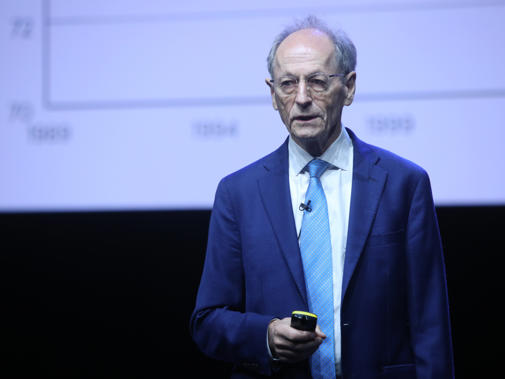The socialist thinker and academic Raymond Williams once observed, ‘to be truly radical is to make hope possible, rather than despair convincing’.
It is a maxim and mindset Professor Sir Michael Marmot subscribes to, even if he readily concedes there is plenty to despair about when it comes to the state of health equity and social inequality in the UK in 2023.
A former president of the BMA a global authority on the determinants of health and the role of social justice in wellbeing, Prof Marmot is the author of the landmark 2010 study Fair society, healthy lives: the Marmot review, with this seminal piece of work itself revisited and reappraised in 2020’s The Marmot Review 10 Years On.
It was with these credentials in mind that Prof Marmot was invited to present the second instalment of the Victor Horsley lecture at this year’s BMA annual representative meeting in Liverpool, in which members had the opportunity to hear Prof Marmot dissect the factors which have contributed to widening disparities in health outcomes.
These include the fact that UK life expectancy, which until 2010 had been increasing around one year every four, has now shrunk by 0.9 years in women and 1.2 years in men.
Height reducing
Meanwhile health and physical development among UK children has been similarly stunted, with the average height of five-year-olds in the UK now ranked 101 out of 200 similar nations, having been 69th in 1985.
‘Our five-year-olds are now seven centimetres shorter than five-year-olds in the Netherlands,’ explains Prof Marmot.
‘The genes didn’t change in that time. Genes determine the heights of individuals. It’s nutrition, infection, poverty, stress [that determine the heights of groups].
‘What we can say is [between 2010 and 2020] we [the UK] had the slowest improvement in health equity of any rich country except Iceland and the USA.
‘I’m concerned with health and the determinants of health, particularly now that the healthcare system is under such threat [and] there have been three huge recent challenges to health inequalities, the decade of austerity, the COVID pandemic, and the cost-of-living crisis.’
COVID co-efficient
While the role of social status in determining an individual’s health outcomes is not a recent observation, understanding the complex interplay of how global events and subsequent government policy has had a direct effect in shaping these outcomes is not always straightforward.
Around the time he was publishing his 10 years on review, Prof Marmot had made clear that the then unfolding COVID-19 pandemic would expose and exacerbate existing health and social inequalities.
The antecedents, however, go back much further, and in many cases are the logical conclusions of political choices and government policies enacted since 2010, with Prof Marmot pointing out that public sector spending had been 42 per cent of GDP in 2009/10 shrinking to 35 per cent by 2019/20.
He said that having recently listened to an interview with George Osborne in which the former chancellor asserted that austerity had helped to drive growth and make the UK’s economic model one that other countries had sought to emulate was laughable.
‘The pandemic is a crisis, but I would argue that the magnitude of health inequalities we had in 2010 should have been a crisis, and yet we chose to cut public expenditure and make things worse,’ Prof Marmot says.
‘George Osborne was the architect of the austerity, I was listening to him on a podcast while I was out for a morning walk today [and] was so annoyed I got a blister.
‘If I had that standard of honesty, and you came to me as a clinician, you’d report me to the GMC. The idea that [austerity] was an economic necessity is garbage.’
Levelling-up enthusiasm
Despite the enthusiasm around the levelling-up agenda promoted under the leadership of former prime minister Boris Johnson, health inequality continues to be hugely varied by geographic region as much as by socio-economic status.
‘If you’re poor, it matters much more where you live, the regional differences are much bigger,’ says Prof Marmot.
‘The consequences of a given level of deprivation for ill-health are bigger in Liverpool and Manchester, Newcastle and Sunderland than they are in London and the south-east.
Such geographical and social disparities even extend across borders, with Prof Marmot outlining how another burgeoning public health issue, that of fuel poverty, had a far greater effect in the UK than in one of its closest neighbours.
He said that, while the richest 10 per cent of the population in France and the UK spend around 6 per cent of their total household income on energy costs, there was a staggering disparity between the two countries poorest 10 per cent.
‘If you’re in the poorest 10 per cent in France, you spend 10 per cent of your income on energy. If you’re the poorest 10 per cent in the UK you spend 18 per cent on energy.
‘That gap between the rich and the poor, in the per cent spent on energy is bigger in the UK than in any other European country. The UK is a very bad place to be poor.’
Fortunately, Prof Marmot believes there is scope for ‘making hope possible’, as doctors and health leaders look towards the years ahead.
Since 2013 the UK Marmot Network has seen a growing number of UK cities and regions become Marmot places, with local authorities in these areas working with the network to decrease health inequities.
It is an approach which has found a receptive audience at a national political level too, with the Labour Party having pledged to build on the approach of Marmot cities in its Build an NHS fit for the future public services statement.

